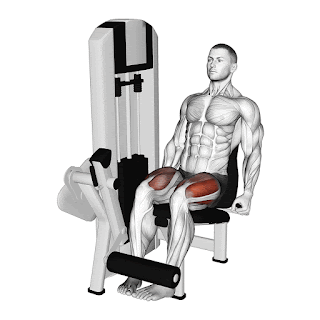 |
| Leg extension exercise |
 |
| Right quadriceps femoris muscle |
The subjects then completed a 10 week training program comprising of 2 strength training sessions each week. This consisted of 3 sets of exercises from week 1-5 and from week 6-10 onwards, 4 sets of exercises. They performed either 15-20 reps of leg extension or if they cannot reach 15-20 reps to failure (where the quads cannot do another rep).
2 pre and post training measurements on the proximal and distal rectus femoris and vastus lateralis muscles were done with ultrasound imaging to compare results.
The findings were that the quadriceps femoris muscle hypertrophied following the 10 weeks of strength training. The rectus femoris part of the quadriceps femoris had significantly greater hypertrophy in both the proximal and distal regions at 40 degrees of hip flexion compared to 90 degrees hip flexion.There were however no hypertrophy changes in the distal proximal and distal regions of the vastus lateralis muscle. This finding was expected as the vastus lateralis is a single joint muscle and its muscle length was constant and did not change during both hip positions.
The authors concluded that performing the leg extension exercise with 40 degrees of hip flexion had superior increases in hypertrophy of the rectus femoris muscle compared to 90 degrees hip flexion. So definitely not always true that you need good posture/ exercise form when exercising.
This is attributed to the longer muscle length in the rectus femoris when the leg extension exercise is performed with the hip at 40 degrees flexion. Note that the rectus femoris is a 2 joint muscle where it can both flex the hip and extend the knee. The other 3 muscles in the quadriceps femoris are capable of only extending the knee. This makes the rectus femoris most prone to muscle strain injuries especially when sprinting and kicking.
The authors suggest that training the rectus femoris with 40 degrees hip flexion would make it stronger and offer a protective effect against rectus femoris strain injuries.
Reference
Larsen S, Kristiansen BS, Swinton PA et al (2024). The Effects Of Hip Flexion Angle On Quadriceps Femoris Muscle Hypertrophy In The Leg Extension Exercise. Sport Rxiv. DOI: 10.51224/SRXiv.407






No comments:
Post a Comment